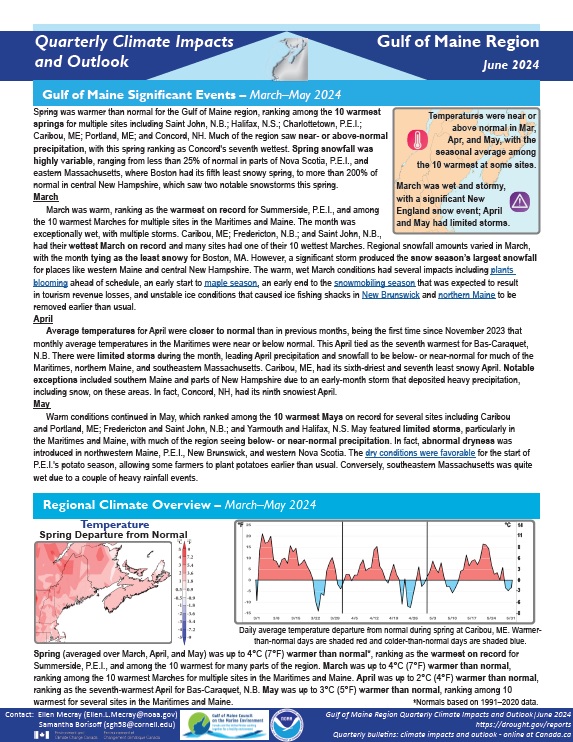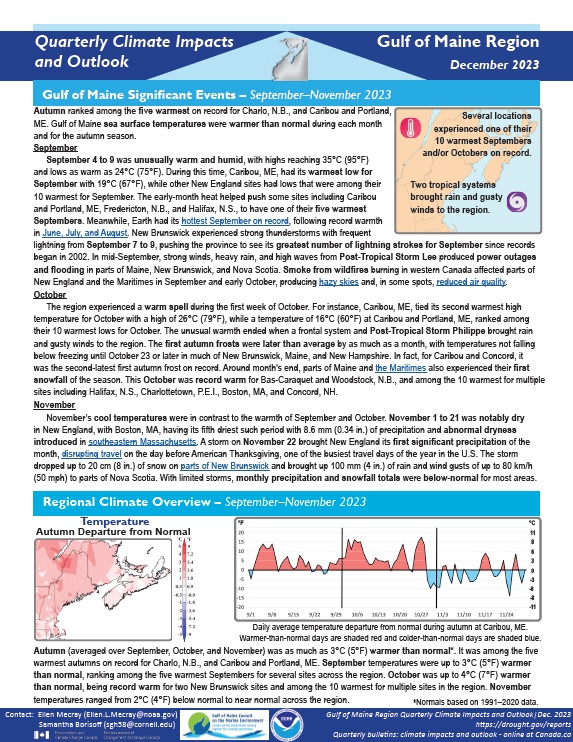Quarterly Climate Impacts and Outlook for the Gulf of Maine Region for March–May 2025. Dated June 2025.
Spring was up to 2°C (4°F) warmer than normal, ranking among the 10 warmest springs for a few sites like Boston, Massachusetts; Halifax, Nova Scotia; and Summerside, Prince Edward Island. Spring precipitation ranged from 75% of normal to 175% of normal, ranking among the 10 wettest for a few sites.
Quarterly Climate Impacts and Outlook for the Gulf of Maine Region for December 2024–February 2025. Dated March 2025.
Winter ranged from 2°C (4°F) colder than normal to 3°C (5°F) warmer than normal. Precipitation for winter ranged from 50% of normal to 175% of normal.
Quarterly Climate Impacts and Outlook for the Gulf of Maine Region for September–November 2024. Dated December 2024.
Autumn was up to 4°C (7°F) warmer than normal. This autumn was record warm for Caribou, ME, and Charlo, N.B., and among the 10 warmest for multiple other sites. Precipitation for autumn ranged from 25% of normal to near normal for most areas.
Quarterly Climate Impacts and Outlook for the Gulf of Maine Region for June–August 2024. Dated September 2024.
Summer was up to 4°C (7°F) warmer than normal. It was record hot for some sites like Caribou, Maine, and Fredericton, N.B., and among the 10 hottest for others. Precipitation for summer ranged from 50% of normal to 175% of normal.
Quarterly Climate Impacts and Outlook for the Gulf of Maine Region for March–May 2024. Dated June 2024.
Spring was up to 4°C (7°F) warmer than normal, ranking as the warmest on record for Summerside, P.E.I., and among the 10 warmest for many parts of the region. Spring precipitation ranged from 50% of normal to 175% of normal. Concord, NH, had its seventh-wettest spring.
Quarterly Climate Impacts and Outlook for the Gulf of Maine Region for December 2023–February 2024. Dated March 2024.
Winter was up to 5°C (9°F) warmer than normal, ranking as the warmest on record for a few sites like Caribou, Maine, and Fredericton, N.B., and among the 10 warmest for multiple areas. Precipitation for winter ranged from 50% of normal to more than 200% of normal.
Quarterly Climate Impacts and Outlook for the Gulf of Maine Region for September–November 2023. Dated December 2023.
Autumn (averaged over September, October, and November) was as much as 3°C (5°F) warmer than normal. It was among the five warmest autumns on record for Charlo, New Brunswick, and Caribou and Portland, Maine. Precipitation for autumn (accumulated from September to November) ranged from 50% of normal to 125% of normal.
Quarterly Climate Impacts and Outlook for the Gulf of Maine Region for June–August 2023. Dated September 2023.
Summer was up to 2°C (4°F) warmer than normal. Precipitation for the summer season ranged from near normal to more than 200% of normal. It was the wettest summer on record for several Maritimes sites and among the 10 wettest for a few other sites in the region.
Quarterly Climate Impacts and Outlook for the Gulf of Maine Region for March–May 2023. Dated June 2023.
Spring was up to 3°C (5°F) warmer than normal. Spring precipitation ranged from 25% of normal to 125% of normal.
NOAA’s Regional Climate Services Program created these climate outlooks to inform the public about recent climate impacts within their respective regions. Each regional report contains easy-to-understand language, and anyone can access them through the Drought Portal.
Quarterly Climate Impacts and Outlook for the Gulf of Maine Region for December 2022–February 2023. Dated March 2023.
Winter (averaged over December, January, and February) was up to 4°C (7°F) warmer than normal, with multiple sites having one of their five-warmest winters on record. Winter precipitation (accumulated from December to February) ranged from near normal to 150% of normal.











